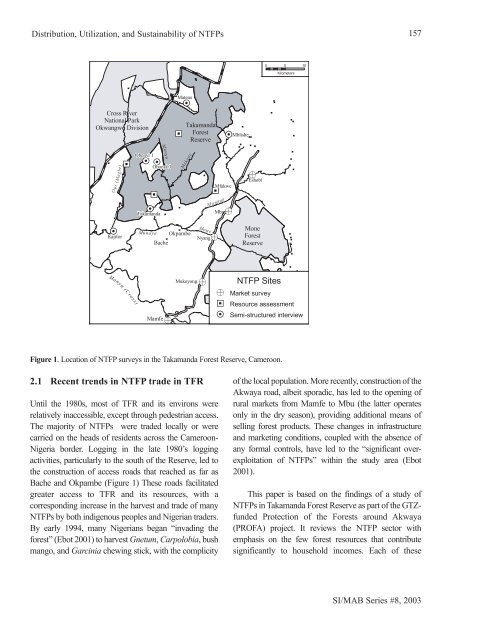Fisheries in the Southern Border Zone of Takamanda - Impact ...
Fisheries in the Southern Border Zone of Takamanda - Impact ...
Fisheries in the Southern Border Zone of Takamanda - Impact ...
Create successful ePaper yourself
Turn your PDF publications into a flip-book with our unique Google optimized e-Paper software.
Distribution, Utilization, and Susta<strong>in</strong>ability <strong>of</strong> NTFPs<br />
Figure 1. Location <strong>of</strong> NTFP surveys <strong>in</strong> <strong>the</strong> <strong>Takamanda</strong> Forest Reserve, Cameroon.<br />
2.1 Recent trends <strong>in</strong> NTFP trade <strong>in</strong> TFR<br />
Until <strong>the</strong> 1980s, most <strong>of</strong> TFR and its environs were<br />
relatively <strong>in</strong>accessible, except through pedestrian access.<br />
The majority <strong>of</strong> NTFPs were traded locally or were<br />
carried on <strong>the</strong> heads <strong>of</strong> residents across <strong>the</strong> Cameroon-<br />
Nigeria border. Logg<strong>in</strong>g <strong>in</strong> <strong>the</strong> late 1980’s logg<strong>in</strong>g<br />
activities, particularly to <strong>the</strong> south <strong>of</strong> <strong>the</strong> Reserve, led to<br />
<strong>the</strong> construction <strong>of</strong> access roads that reached as far as<br />
Bache and Okpambe (Figure 1) These roads facilitated<br />
greater access to TFR and its resources, with a<br />
correspond<strong>in</strong>g <strong>in</strong>crease <strong>in</strong> <strong>the</strong> harvest and trade <strong>of</strong> many<br />
NTFPs by both <strong>in</strong>digenous peoples and Nigerian traders.<br />
By early 1994, many Nigerians began “<strong>in</strong>vad<strong>in</strong>g <strong>the</strong><br />
forest” (Ebot 2001) to harvest Gnetum, Carpolobia, bush<br />
mango, and Garc<strong>in</strong>ia chew<strong>in</strong>g stick, with <strong>the</strong> complicity<br />
157<br />
<strong>of</strong> <strong>the</strong> local population. More recently, construction <strong>of</strong> <strong>the</strong><br />
Akwaya road, albeit sporadic, has led to <strong>the</strong> open<strong>in</strong>g <strong>of</strong><br />
rural markets from Mamfe to Mbu (<strong>the</strong> latter operates<br />
only <strong>in</strong> <strong>the</strong> dry season), provid<strong>in</strong>g additional means <strong>of</strong><br />
sell<strong>in</strong>g forest products. These changes <strong>in</strong> <strong>in</strong>frastructure<br />
and market<strong>in</strong>g conditions, coupled with <strong>the</strong> absence <strong>of</strong><br />
any formal controls, have led to <strong>the</strong> “significant overexploitation<br />
<strong>of</strong> NTFPs” with<strong>in</strong> <strong>the</strong> study area (Ebot<br />
2001).<br />
This paper is based on <strong>the</strong> f<strong>in</strong>d<strong>in</strong>gs <strong>of</strong> a study <strong>of</strong><br />
NTFPs <strong>in</strong> <strong>Takamanda</strong> Forest Reserve as part <strong>of</strong> <strong>the</strong> GTZfunded<br />
Protection <strong>of</strong> <strong>the</strong> Forests around Akwaya<br />
(PROFA) project. It reviews <strong>the</strong> NTFP sector with<br />
emphasis on <strong>the</strong> few forest resources that contribute<br />
significantly to household <strong>in</strong>comes. Each <strong>of</strong> <strong>the</strong>se<br />
SI/MAB Series #8, 2003

















